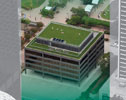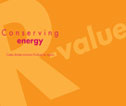UL announces Dual Evaluation and Certification Program
Underwriters Laboratories (UL) Inc. and ICC Evaluation Service Inc.® (ICC-ES) have announced the Dual Evaluation and Certification Program for the building products industry. The program is designed to provide a streamlined approach to demonstrating compliance with the International Building Code® (IBC) and International Fire Code® (IFC).
Manufacturers of building products and systems can benefit from the program, which reportedly provides faster turnaround for the ICC-ES evaluation report and UL certification; a comprehensive and collaborative framework for testing, inspecting, certifying and evaluating building products; placement in product directories on UL's and ICC-ES's Web sites; inclusion in UL's code correlation database, www.ul.com/regulators/codelink; products' acceptance by authorities having jurisdiction; ability to leverage the strength of the ICC-ES and UL brands; acceptance of products where IBC or IFC codes have been adopted; a single point of contact for manufacturers desiring an ICC-ES Evaluation Report and UL certification; broader exposure for building products through the network of ICC-ES and UL relationships; and the use of the ICC-ES and UL marks.
For more information or to apply for the program, contact Marty Pabich, UL's program owner, at (847) 664-3332 or Martin.J.Pabich@us.ul.com or Bohdan Horeczko, ICC-ES's director of professional services, at (800) 423-6587, ext. 3210 or BHoreczko@icc-es.org.
To learn more about the Dual Evaluation and Certification Program and view frequently asked questions regarding the program, visit www.ul.com/fire.
Avoid mistakes when praising employees
Praise can be a strong motivational tool when it is used properly; however, mistakes can undercut praise's intended purpose. Following are some common mistakes to avoid when praising employees:
- Praising the wrong behavior. Take time to think about the behaviors you want your employees to demonstrate, and only praise those behaviors. For example, if you want to improve your company's safety record, don't praise employees for reporting fewer accidents—this may only encourage them to stop reporting accidents. Instead, observe safety procedures, and praise employees who are taking the proper precautions.
- Misunderstanding effects. Praising an individual can have a positive effect on an entire group. You may be reluctant to embarrass a shy employee with public praise, but be sure to find some way to make your positive message known. This will demonstrate to other employees that their individual efforts can benefit the group.
- Mixing praise and criticism. Mixed messages often can confuse the receiver. If you need to criticize an employee, be honest and upfront about it, but don't mix praise with criticism. When praising an employee, save criticism for another time.
- Giving exaggerated praise. Providing exaggerated or undeserved praise can cause cynicism among receivers. Be sure to praise people in proportion to their efforts.
- Overlooking consistent workers. It is easy to overlook the performance of an employee whose work is consistently good.
Remember to praise employees who perform good work but may not draw attention to themselves.
Source: Adapted from The Motivational Manager, December 2009 issueFirst integrated green construction code to be released
The first integrated green code for traditional and high-performance commercial buildings—the International Code Council's (ICC's) International Green Construction Code (IGCC)—is set to be released this month.
The IGCC is designed to integrate and coordinate with existing international codes being enforced by government code officials at all levels. The IGCC's drafting approach links the international codes to a public process that invites continual public input, culminating in final approval from code officials to ensure the best possible rate of compliance.
"This will be the first time code officials, owners and designers will have an integrated regulatory framework to put into practice that meets the goal of 'greening' the construction and design of new and existing buildings," says Richard Weiland, ICC's chief executive officer. "Only a code that is useable, enforceable and adoptable will affect our built environment in dramatic ways."
The first public version of the IGCC is expected to inform many policy discussions currently under way. At that time, the IGCC will undergo continual maintenance with the solicitation of additional public comments through hearings that will be conducted in August. The IGCC then will go through another round of reviews, comments and public hearings in 2011 for the publication of the 2012 ICC Family of Codes.
More information about the IGCC is available at www.iccsafe.org/igcc.
National lab creates smaller solar cells
According to the Massachusetts Institute of Technology's Technology Review, researchers at Sandia National Laboratories, Albuquerque, N.M., have created microscopic silicon solar cells that use 100 times less material and operate with the same efficiency as traditional solar cells.
The solar cells are between 0.25 and 1 mm in diameter and can be manufactured about 10 times thinner than conventional solar cells, making their main benefit lower material costs.
The cells are about 20 micrometers thick and reportedly have the same efficiency as conventional solar cells, converting about 14.9 percent of sunlight into electrical energy. According to the report, the process used to manufacture the solar cells also makes it easier to make the cells in a hexagonal shape, which makes the most of the available area without wasting much silicon.
Tips for terminating an employee
Although terminating an employee is never a happy matter, it sometimes is necessary. Follow these guidelines to ensure you handle the situation properly.
- Carefully review the situation and your company's termination policy before taking any action to ensure all procedures are conducted properly.
- Prepare an outline of everything you need to say during the termination meeting.
- Anticipate how the employee may react to the termination so you can prepare how you will respond.
- Include at least one other supervisor to witness the termination meeting and provide assistance if necessary.
- Choose a private location away from the employee's co-workers to conduct the termination meeting.
- Choose a way for the terminated employee to exit the building that creates the least amount of embarrassment for the employee and disruption to co-workers.
- Write a summary report of the termination meeting and keep it in your files.
- Be sure to address the situation with others. When appropriate, notify remaining employees and any other affected parties, such as customers.
Source: Adapted from The Manager's Intelligence Report, January issue
Details
Kelly Luckett
What is your position within your company?
I am president of Green Roof Blocks and Saint Louis Metalworks Co., St. Louis.
What is the most unusual roofing project of which you have been a part?
Ten years ago, I would have said covering rooftops with plants was unusual. But now, nothing seems more natural. Although there are unique aspects of every green roof project, the most unusual job that comes to mind is the pet park at the Vue Condominium on Lake Eola in Orlando, Fla. We were commissioned to create a green roof system where the tenants could walk their dogs. The 850-square-foot pet park is planted with a salt-tolerant grass and equipped with an irrigation system that flushes water through the green roof system each night.
Why did you become involved with the roofing industry?
Like many of us in the trades, I followed my father into the roofing business. Although initially roofing was just a good-paying job that helped me pay for college, doors that have opened for me in the roofing industry have allowed me to provide a nice living for my family.
What was your first roofing experience?
When I was 17, my father hired my older brother and me to help with a weekend shingle job for a family friend's home. The house was two stories tall, and the roof was steep. We used ropes tied to the bumper of my dad's car to hold on to while we tore off the three layers of shingles. The work was grueling, but when my dad put $200 in my hand Sunday afternoon, I knew my days of flipping burgers were over.
If you could travel anywhere in the world, where would you go?
We travel often, and we love beach locations most, so for us, paradise is a warm tropical setting with white sand, blue water and fruity drinks.
What do you consider a waste of time?
Lately, watching the St. Louis Rams play feels a lot like wasted time, but each Sunday I perpetuate the misery.
List three words that best describe you.
Tenacious, optimistic and humorous
What is your biggest pet peeve?
People who refuse to recycle; it's easy, and it's so important.
If you could invite any three people (dead or alive) to dinner, whom would you invite and why?
One of my lifelong passions is tuning into the network news to get informed about the issues of the day. I'd love to spend an evening discussing current events with some of the people I've been bringing into my living room: Tom Brokaw, Brian Williams and George Stephanopoulos.
What is the most challenging aspect of your job?
Staying on top of modern communication. I used to designate a specific time each day to address letters and faxes and return telephone messages. Now, e-mails and text messages stream in continuously and monopolize about half of my workday.
What is your roofing industry involvement?
I work on various committees for ASTM International, SPRI and Green Roofs for Healthy Cities. I also am an instructor for NRCA University's Vegetative Roof Systems for Roofing Contractors: Your Rewards, Responsibilities and Risks.
People would be surprised to know …
I have been a computer geek since the early 1980s. I owned a Commodore VIC-64 that used my television as the monitor and cassette tape recorder for data storage. A friend and I created an estimating program for roofing in a computer programming language known as BASIC a decade before Windows® changed our lives.
California adopts mandatory green building code
The California Building Standards Commission has adopted CALGREEN, the first mandatory green building standards code in the U.S.; the code requires all new buildings in the state to be more energy-efficient and environmentally responsible. Taking effect Jan. 1, 2011, the regulations are designed to achieve major reductions in greenhouse gas emissions, energy consumption and water use in California.
CALGREEN will require the construction of every new building in California to reduce water consumption 20 percent, divert 50 percent of construction waste from landfills and install low-pollutant-emitting materials. The regulations also will require separate water meters for nonresidential buildings' indoor and outdoor water use with a requirement for moisture-sensing irrigation systems for larger landscape projects and mandatory inspections of energy systems for nonresidential buildings larger than 10,000 square feet to ensure all are working at maximum capacity and according to their design efficiencies. The California Air Resources Board estimates the mandatory provisions will reduce greenhouse gas emissions by 3 million metric tons by 2020.
California's property owners can label their facilities as CALGREEN-compliant upon passing state building inspection.
"With this first-in-the-nation mandatory green building standards code, California continues to pave the way in energy efficiency and environmental protection," says California Gov. Arnold Schwarzenegger. "Today's action lays the foundation for the move to greener buildings constructed with environmentally advanced building practices that decrease waste, reduce energy use and conserve resources."
Half of nonresidential buildings will be green by 2015
According to a new study from New York-based venture capital firm Good Energies Inc., by 2015, about half of nonresidential buildings in the U.S. will be green buildings. Currently, green buildings make up about 15 percent of nonresidential buildings.
To define what qualifies as a green building for the study, Greg Kats, Good Energies' senior director and director of climate change, used the U.S. Green Building Council's (USGBC's) Leadership in Energy and Environmental Design (LEED®) standards. To be considered a green building, LEED certification wasn't required; however, the building had to adhere to LEED standards.
In conducting the study, Kats and his partners interviewed 100 architects working on 170 nonresidential green buildings located mostly in the U.S. He also obtained information from USGBC, The American Institute of Architects, American Public Health Association, National Association of Realtors, Building Owners and Managers Association International, Federation of American Scientists, Real Estate Roundtable, National Association of State Energy Officials, Enterprise Community Partners and World Green Building Council. The interviews were used to estimate green buildings' growth rate during the next five years.
Kats' study also concluded that builders and building owners are beginning to realize green building isn't as expensive as they previously may have thought; this may help increase the number of green buildings. Using a 2007 survey conducted by the Washington, D.C.-based World Business Council, Kats concluded that a nonresidential green building costs about 2 percent more than a comparable traditional building though, on average, the public thinks it costs 17 percent more.
Kats published the results of his study in a book, Greening Our Built World, which was released in November 2009.



